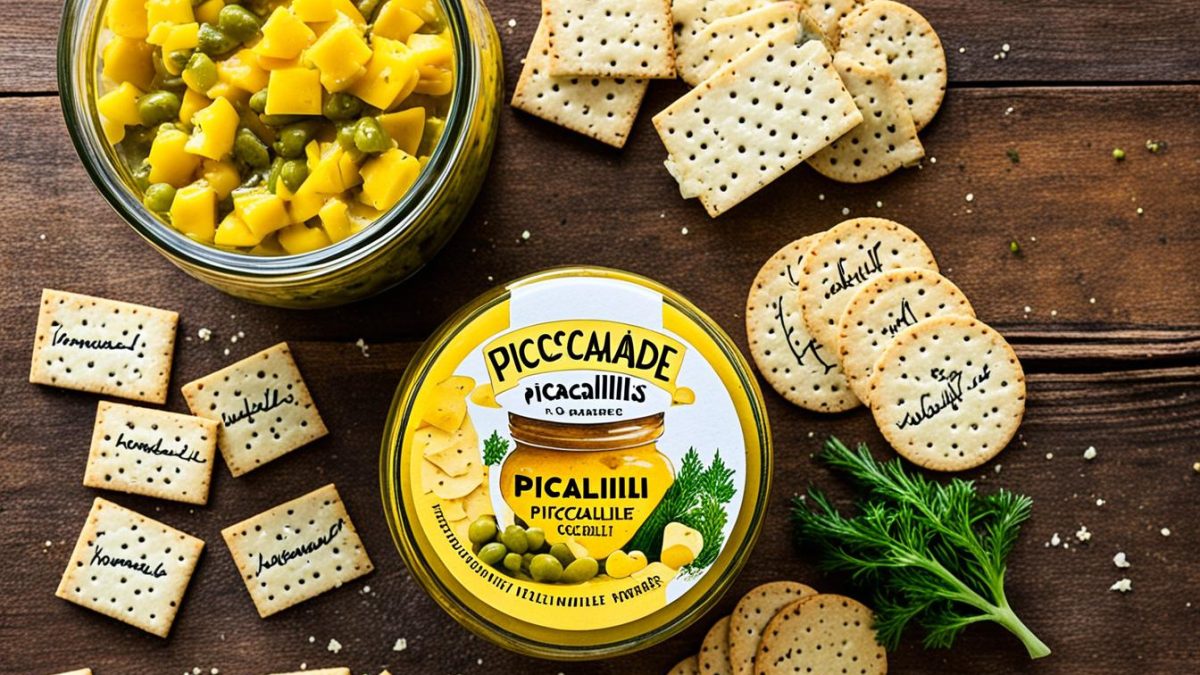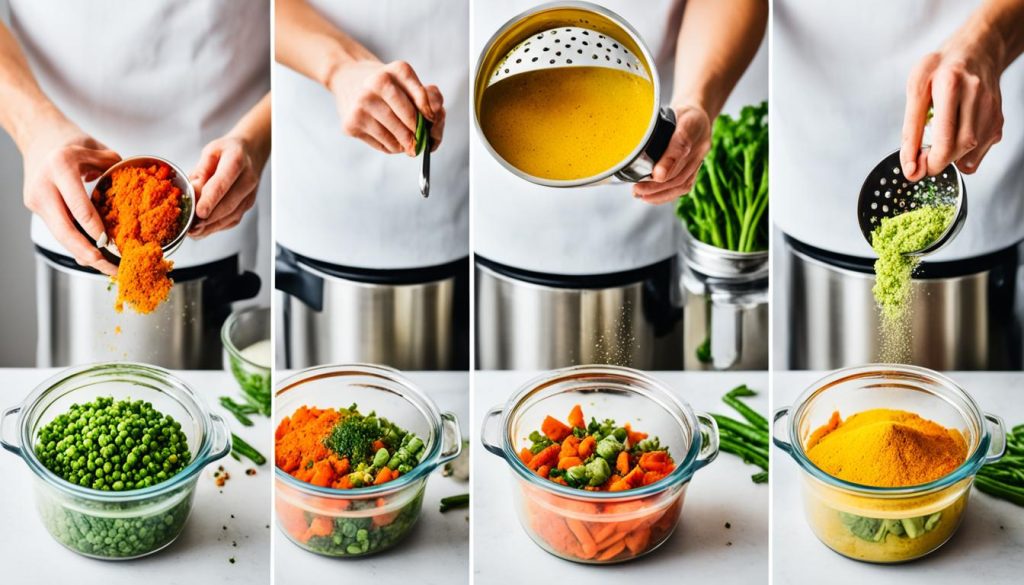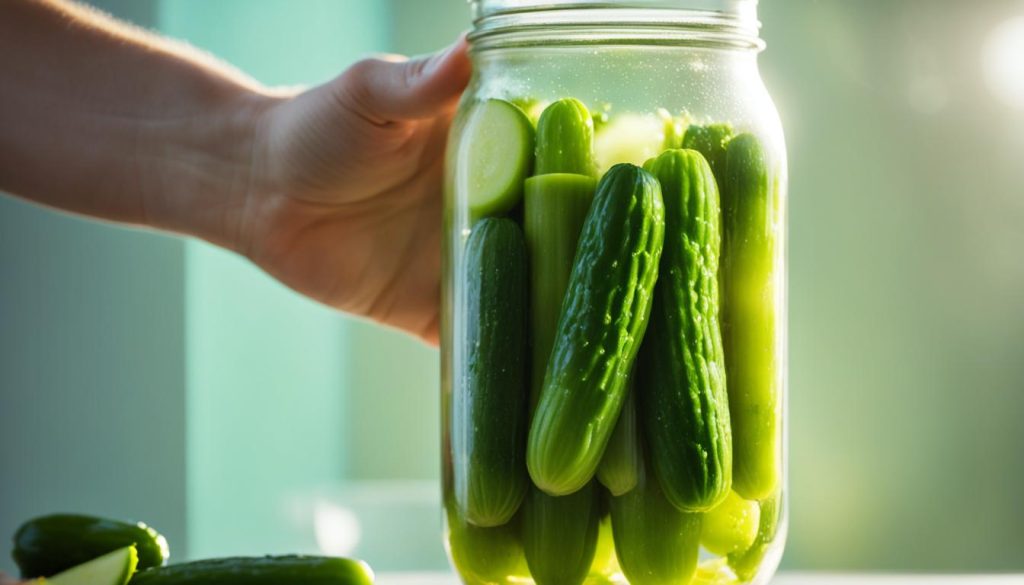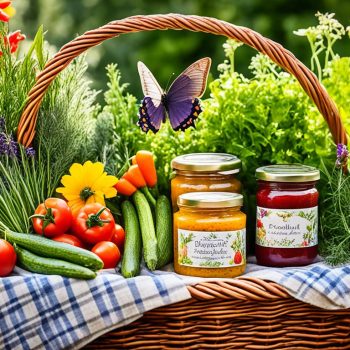
Piccalilli Recipe | Tangy Homemade English Pickle Relish!
Enliven your palate with the quintessential burst of British cuisine – the beloved homemade piccalilli. This vibrant traditional British pickle stands as a cornerstone of the country’s culinary delights, offering a tangy hit to an array of meals. Renowned for its unique amalgamation of mustard and turmeric, this delectable piccalilli relish can effortlessly transform mundane sandwiches or plain cold meats into gastronomic wonders, infusing them with a delectably zesty twist.
Delve into the pleasures of creating your very own piccalilli condiment. Indulge in the simplicity of its preparation, making the most of the fresh, crunchy vegetables that each season generously offers. Whether opting for garden staples such as cauliflowers and onions or integrating more adventurous elements like nasturtium seeds and courgettes, you can tailor your piccalilli for a truly personal touch or to preserve an abundant harvest. The art of piccalilli making, encompassing a salting of vegetables followed by a gentle simmer in aromatic spiced vinegar, culminates in a tangy English pickle that intensifies in flavour over several weeks of ageing in the solace of a cool, darkened nook.
Exploring the Origins of Piccalilli
Delving into the storied past of piccalilli reveals a fascinating blend of British culinary traditions and exotic influences brought about through historic trade routes. This beloved mustard pickle, with its tangy and robust flavours, carries with it a rich narrative that stretches across continents and centuries.
The Evolution of Piccalilli through British History
The journey of piccalilli through British history is marked by its transformation and adaptation. Originating in the 18th century, the recipe has been influenced by notable culinary figures such as Elizabeth Raffald and Mrs Beeton, whose contributions to british piccalilli history have been well-documented in their cookbooks. Raffald’s recipe for an ‘Indian pickle’ and Mrs Beeton’s detailed descriptions in her household management guides are prime examples of how piccalilli was integrated and cherished in British cuisine.

Culinary Influences and the Indian Connection
The India trade influences on piccalilli are particularly significant, introducing a plethora of spices and pickling techniques to British soil. The use of turmeric, mustard, and other spices were catalysed by Britain’s commercial ties with India, enriching the traditional recipes with vibrant colours and piquant flavours that define the mustard pickle today.
Hannah Glasse’s recipe for ‘paco lilla’ evidently reflects the early adoption of Indian spices, showing how global trade moulded British culinary tastes.
Piccalilli’s tantalising fusion of spices and preservation methods not only highlights the global influences on British cuisine but also showcases the adaptability and innovation within traditional food practices.
Essential Ingredients for a Classic Piccalilli Recipe
Selecting the right piccalilli ingredients is paramount to creating this vibrant British condiment. Every ingredient, from the crisp vegetables to the piquant spices and tangy vinegar, contributes to the rich tapestry of flavours found in homemade piccalilli.
Choosing Vegetables: From Cauliflowers to Cucumbers
For your vegetable piccalilli, cauliflower often takes centre stage, hailed for its firm texture which marries well with robust spices. Complementing the cauliflower, onions, gherkins, and carrots add depth, while cucumbers, green beans, and courgettes introduce fresh contrasts. Ensuring these vegetables are fresh is critical as it affects the crunch and overall flavour of the piccalilli.
The Role of Spices in Crafting the Perfect Taste
Mustard seeds and turmeric are quintessential in achieving the classic golden hue and pungent taste of piccalilli. While these piccalilli spices lay the foundation, exploring with additional spices like ginger, cumin, and coriander seeds can add intriguing layers of flavour, enhancing the complexity of the condiment.
Understanding Vinegars and Their Acidity Levels
The selection of vinegar is crucial, not just for flavour but also for preserving the piccalilli safely. Cider vinegar, with its mild fruity undertones, and white distilled vinegar, known for its clean taste, are excellent choices. These vinegars should possess an acidity level of at least 5%, ensuring they are potent enough to preserve the piccalilli effectively.
| Vegetable | Common Spices | Recommended Vinegar |
|---|---|---|
| Cauliflower, Cucumbers, Gherkins | Turmeric, Mustard Seeds | Cider Vinegar |
| Carrots, Green Beans | Coriander Seeds, Cumin | White Distilled Vinegar |

Step-by-Step Guide to Making Homemade Piccalilli
Embracing the crafting of homemade piccalilli can be both a delightful and rewarding kitchen endeavour. This guide will walk you through the essential phases of piccalilli preparation, ensuring each step from salting to sterilising is meticulously executed for the perfect batch of this traditional British condiment.
The Importance of Salting and Its Impact on Texture
In the initial stage of how to make piccalilli, vegetables such as cauliflower, onions, and cucumbers are liberally seasoned with salt. This salting period, which ideally lasts for about 24 hours, is crucial as it draws out moisture, ensuring that the vegetables retain their crunchiness after being submerged in the vinegar mix. This step not only prepares the vegetables for the pickling process but also enhances their texture, crucial for a premium homemade pickle experience.
Mastering the Piccalilli Making Process
The core of the piccalilli making process involves the preparation of a spicy vinegar concoction. Once the vegetables have been rinsed of their salt, they are combined with this aromatic, turmeric-infused vinegar sauce. Ensuring that the sauce adequately penetrates and coats the vegetables is essential for achieving the vibrant flavour and texture piccalilli is renowned for.

Sterilising Jars for Longevity of Your Pickle
Prior to the filling, sterilising jars is a pivotal step in the piccalilli preparation process. Sterilisation eliminates harmful bacteria, ensuring the safety and extending the shelf life of your piccalilli. Jars should be thoroughly cleaned and then heated, either in boiling water or an oven, just before the hot piccalilli mix is poured into them. This practice not only guarantees a safely preserved product but also maintains the fresh taste and crunch of the pickle.
Following these steps ensures your homemade piccalilli not only tastes great but is also safe and stable enough to be stored. With the right approach to homemade pickle technique, you’ll be able to enjoy your tangy, spiced creation for months to come.
Piccalilli Recipe
Savour the essence of British summertime with a classic piccalilli recipe, where garden-fresh vegetables meet a symphony of spices. This mustard pickle recipe is a delight for those who cherish vibrant, spiced condiments alongside their meals.
Beginning with a robust base of cauliflower, onions, and gherkins, each element is chopped into bite-sized pieces, setting the stage for their transformation into an aromatic spiced vegetable relish recipe. The magic unfolds as these crisp vegetables are combined with a rich dressing of malt vinegar, sugar, fine salt, mustard powder, and turmeric. The addition of a touch of cornflour helps meld these ingredients into a thick, golden sauce that clings lovingly to the vegetables, encapsulating them in flavour.
The concoction is then gently simmered to coax the vegetables into tender perfection before being preserved in sterilised jars. As these pots seal, the ingredients within embark on a transformative journey. Over the weeks, the sharp tang of the vinegar, the sweetness of the sugar, and the complex notes from the spices come into a harmonious balance, maturing into what is proudly served as an English garden pickle recipe.
This homemade chutney and pickle recipe becomes a testament to the preservation art, capturing the peak of garden freshness in every jar. Below is a detailed breakdown of ingredients and steps to guide you through creating your batch of piccalilli.
| Ingredient | Quantity | Preparation |
|---|---|---|
| Cauliflower | 500g | Chop into small florets |
| Onions | 300g | Slice finely |
| Gherkins | 200g | Dice evenly |
| Malt Vinegar | 500ml | Combine with spices |
| Mix of Mustard Powder and Turmeric | 2 tablespoons | Blend well |
| Sugar and Fine Salt | 100g sugar, 2 tsp salt | Stir into vinegar mix |
| Cornflour | 2 tablespoons | Use to thicken the sauce |

The rich history and delightful crunch of this piccalilli not only cater to traditional tastes but also adapt beautifully to modern palates, making it a versatile, year-round companion to meats, cheeses, and more. With each spoonful, relish the taste of an English garden encapsulated in a jar, a hearty tribute to the flavoursome art of pickling.
Tips and Tricks for the Perfect Homemade Piccalilli
Mastering the craft of homemade piccalilli opens up a world of flavourful opportunities to enhance your meals. Key to this mastery are the techniques of piccalilli canning and the sensitive balancing of piccalilli flavours, which together ensure both longevity and delicious taste.
Balancing the Flavours: Sweetness and Heat
At the heart of balancing piccalilli flavours lies the intricate dance between sweetness and piquancy. A successful piccalilli strikes a harmonious balance where the sweetness of the added sugars complements, rather than overwhelms, the tartness of the vinegar and the heat from the spices. Advanced home chefs might experiment with piccalilli variations, adjusting the level of chillies or even adding unique elements like apple cider to introduce a subtle complexity.
Canning Considerations for Piccalilli Preservation
Effective piccalilli canning is essential for preserving its high quality over time, and several factors need careful consideration. The use of plastic-lined metal lids is crucial to prevent the corrosive effect of vinegar on metal, thus preserving the integrity of the canning jars. Additionally, maintaining a consistent water bath temperature during the canning process is imperative for safeguarding the piccalilli’s texture and taste. This ensures that each jar from your kitchen can stand the test of time, always ready to add zest to any platter.
As for piccalilli serving suggestions, this vibrant condiment is remarkably versatile. It can elevate a simple sandwich, provide a tangy contrast to cheese boards, or complement a traditional ploughman’s lunch. Below, a table lists some recommended pairings to help you enjoy your homemade piccalilli to the fullest:
| Dish | Serving Suggestion |
|---|---|
| Sandwiches | Spread a generous layer of piccalilli over ham or cheese sandwiches |
| Cheese Boards | Pair with sharp cheddars or creamy bries to enhance the flavour contrasts |
| Roasted Meats | Serve as a condiment with pork roasts or cold meats |
| Salads | Add a spoonful to potato or pasta salads for an extra tang |
Each use not only showcases the versatility of piccalilli but also underlines how home canning can transform simple dishes into memorable gastronomic experiences. By mastering the subtleties of piccalilli preparation and preservation, you ensure a staple in your culinary repertoire, ready to impress at every meal.
Conclusion
In the panorama of traditional British cuisine, piccalilli asserts its role as a revered classic, interwoven with the rich tapestry of homemade conserves significance. This vibrant condiment thrives on the principles of time-honoured home-curing practices, offering a burst of tangy, musty flavours that unfailingly complement the communal aspect of familial feasts and wholesome dishes. The craft of creating homemade piccalilli is more than mere preservation—it’s a celebration of the Piccalilli legacy, rooted firmly in British gastronomic heritage.
Homemade piccalilli enjoyment stretches beyond the bounds of its bright yellow hue and invigorating taste. It encompasses the sheer delight and satisfaction one finds in the alchemy of transforming simple garden produce into a storied concoction, rich with cultural essences and reminiscent of comforting home kitchens. Whether it graces your cheese boards, amplifies the taste of cold cuts, or simply stands alone, homemade piccalilli becomes the star at the table—its presence as anticipated as any main course.
Let us not underestimate the role of piccalilli as a stalwart of the condiment world; its place within the British culinary repertoire is both historic and dynamic. As creators and consumers of this cherished relish, we ensure its perpetual reinvention and relevance in our kitchens. It is the embodiment of tradition that meets innovation, where every jar of piccalilli is not just a spread but an inherited slice of British living, promising relishable moments for years to come.
FAQ
What is traditional British piccalilli?
Traditional British piccalilli is a tangy mustard pickle, usually consisting of chopped vegetables like cauliflowers and onions, enrobed in a spicy mustard and vinegar-based sauce, tinged with turmeric. It is commonly served as a relish alongside meats, cheeses, and sandwiches.
What are some of the traditional spices used in piccalilli?
The traditional spices in piccalilli often include mustard powder and turmeric, which contribute to its characteristic yellow colour and piquant flavour. Historically, recipes also featured ginger, cumin, coriander seeds, and occasionally allspice or cloves.
How do you make piccalilli at home?
Making piccalilli at home typically involves chopping a variety of vegetables, salting them to draw out moisture, and then rinsing and mixing them with a spiced vinegar solution thickened with cornflour. The mixture is then boiled, jarred, and sealed to preserve. It’s a straightforward process that results in a vibrant and flavourful condiment.
What types of vinegar can be used for piccalilli?
Mild-tasting vinegars like cider, rice, or white wine vinegar are preferred for making piccalilli, and it’s important that they have an acidity level of at least 5% to ensure preservation and safety of the pickle.
How long does homemade piccalilli last?
Once sealed in sterilised jars, homemade piccalilli can last for several months to a year if stored in a cool, dark place. The flavours tend to mature and develop over time, usually reaching their peak after a few weeks of resting.
What vegetables are commonly used in piccalilli?
Common vegetables used in piccalilli include cauliflowers, onions, gherkins, carrots, cucumbers, green beans, and courgettes. However, the choice of vegetables can be tailored according to personal taste and seasonal availability.
Can you adjust the flavour of piccalilli?
Yes, the flavour of piccalilli can be adjusted according to personal preference. Sweetness can be managed with sugar or honey, and heat can be introduced through chillies or increased mustard powder for a spicier edge.
What is the importance of sterilising jars for piccalilli?
Sterilising jars is critical in the making of piccalilli as it eliminates any harmful bacteria that could cause spoilage. It also helps to ensure a safe pickle with a prolonged shelf life.
Are there any specific tips for the piccalilli canning process?
During the canning process, it is essential to use a water bath, adjust times for altitude if necessary, and utilise plastic-lined metal lids to prevent corrosion from the vinegar. This ensures the piccalilli is properly sealed and remains safe to consume.
How do you serve piccalilli?
Piccalilli can be served as a condiment with cold meats, cheese, a ploughman’s lunch, or added to sandwiches for extra zing. It’s versatile and pairs well with most savoury dishes that benefit from a tangy, spicy kick.
Is there any historical significance to piccalilli?
Piccalilli has a rich history dating back to the 18th century in Britain, influenced by the spices brought back from India. It reflects the fusion of British preserving traditions with the exotic flavours of the empire and remains a beloved staple of British cuisine.

Piccalilli Recipe
Ingredients
- 500 g Cauliflower chopped into small florets
- 300 g Onions finely sliced
- 200 g Gherkins diced evenly
- 500 ml Malt Vinegar
- 2 tablespoons Mix of Mustard Powder and Turmeric blended well
- 100 g sugar
- 2 tsp salt
- 2 tablespoons Cornflour to thicken the sauce
Instructions
- Chop cauliflower into small florets, slice onions finely, and dice gherkins evenly.
- Combine malt vinegar with mustard powder, turmeric, sugar, and salt. Blend well to ensure all ingredients are incorporated.
- Add cornflour to the vinegar mix to thicken the sauce, ensuring it coats the vegetables well.
- In a pot, combine the prepared vegetables with the vinegar mix. Stir gently to coat the vegetables evenly.
- Gently simmer the mixture to soften the vegetables and allow the flavors to meld together.
- Ensure jars are thoroughly cleaned and sterilized to preserve the piccalilli. Heat them in boiling water or an oven.
- Once the piccalilli mixture is ready, carefully fill the sterilized jars with the hot mixture.
- Seal the jars tightly to preserve the piccalilli for long-term storage.
- Allow the piccalilli to age in a cool, dark place for several weeks to intensify the flavors before enjoying.

